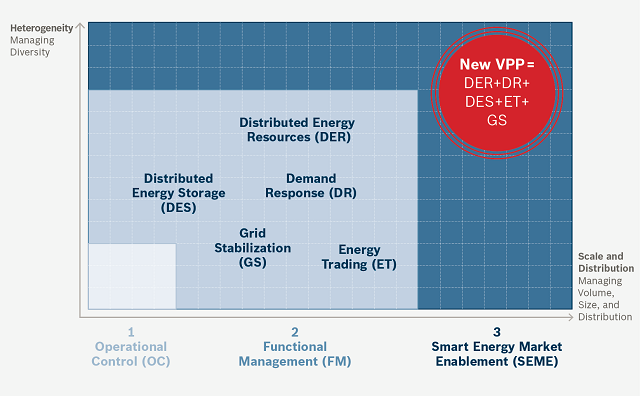
Amidst tightening environmental policies worldwide, clean energy options such as solar, wind and geothermal &ndash in lieu of carbon-based fuels &ndash will eventually represent a large share of global energy needs. This is further driven by enterprises keen to enhance operational efficiency while reducing environmental footprints. We expect to see more enterprises leverage on intelligent systems to provide intelligent energy management solutions.
Where is the demand coming from?
Environmental concerns, inefficient distribution networks resulting in higher costs for energy transmission, rising energy consumption and increasing awareness by consumers with regards to differentiated energy pricing have also resulted in growing interest by public and private organizations to manage their energy demand more intelligently.
As a result, the traditional energy production model of centralized power plants are increasingly shifting towards the management of Distributed Energy Resources (DERs), which are smaller power sources that can be aggregated to provide power on a regular basis, through Virtual Power Plants (VPPs).
So why Virtual Power Plants?
The main idea behind VPP technology is to develop and package flexibility into energy generation and consumption. There are two types of traditional VPP models:
1. Operational Control (OC) model focuses on direct operational control of single assets. The goal here is to simply control and manage assets.
2. Functional Management (FM) model focuses on the management and aggregation of distributed energy sources. The goal here is to optimize the few connected assets while taking into consideration other factors such as cost, heat generation, and energy market prices.
However, these traditional VPP models still lack intelligence at the asset level. For example, software in each asset will enable the assets to respond to time schedules and thus function independently. These assets also come in different types and sizes, and interfaces. Traditional VPP models simply do not have the flexibility to integrate such dissimilar assets in large quantities. Simply put, they cannot adapt quickly.
To address these shortcomings, a new generation of VPPs have emerged.
Key difference between traditional and new VPPs
The fundamental change between the two models is the shift from a single control room managed environment to a decentralized intelligent software managed environment, where the components of smart energy market can take, interact and fulfil requests.
Introducing the next generation VPP
The new generation of VPPs, the Smart Energy Market Enablement (SEME) model, can manage an interconnected market of energy devices through the intelligent application of software tools and systems. Unlike the traditional VPP, modern VPPs combine the energy schedules of all plants to create a balancing load system. The system analyses the demand-side and conducts portfolio management with the aim of optimization savings potential. In essence, the new VPPs can continuously determine the ideal energy amount to be produced before and comparing it with the storage capacities available, taking into account the minimum needed to meet existing needs while ensuring sufficient energy load for additional consumption.

Source: Whitepaper: A new generation of Power Plants (Machina Research, 2014)
The SEME model delivers a management tool, which is enhanced by IoT, to connect Distributed Energy Resources (DERs), Demand Responses (DRs) and Distributed Energy Storage (DESs) as illustrated by the image above. The result is an integration of information and operational technologies, defined by three approaches: the level of abstraction, the flexibility in service request management and lastly, the creation of aggregated profiles representing the generation, consumption or storage capacity of all assets.
Ultimately, VPPs focus on efficiently distributing energy resources and managing production and demand, integrating storage, mobility and smart home, and applying intelligence across the transforming energy market.
To summarize, the scalability, openness and flexibility of IoT solutions, and their ability to leverage significant benefits of connected devices have played a big role in the development of the new generation VPPs.
It is possible for businesses to cost-effectively plan, control and monitor their energy supply, consumption and storage with minimal infrastructural changes, when leveraging on the new generation VPPs. This creates practical and productive business models, and also encourages a decentralized industry better poised to adapt to changes around energy availability and efficiency.
Learn more about the new generation VPPs. Sign up for a free webinar session and compare your VPP against the benchmark of a new generation VPP evaluated by Machina Research. Download the scoring chart today.
About Bosch Software Innovations
Bosch Software Innovations GmbH, the Bosch Group&rsquos software and systems house, designs, develops, and operates innovative software and system solutions that help our customers around the world both in the Internet of Things (IoT) and in the traditional enterprise environment. We place particular focus on the topics of mobility, energy, manufacturing, and building. Our IoT platform &ndash the Bosch IoT Suite &ndash allows the interaction of devices, users, companies and partners on a centralized platform. This enables the development of innovative and future-oriented solutions for new business models. With some 550 associates worldwide, Bosch Software Innovations has locations in Germany (Berlin, Immenstaad, and Stuttgart), Singapore, China (Shanghai), and the United States (Chicago and Palo Alto). More information can be found at www.bosch-si.com
By : Bosch Software Innovations